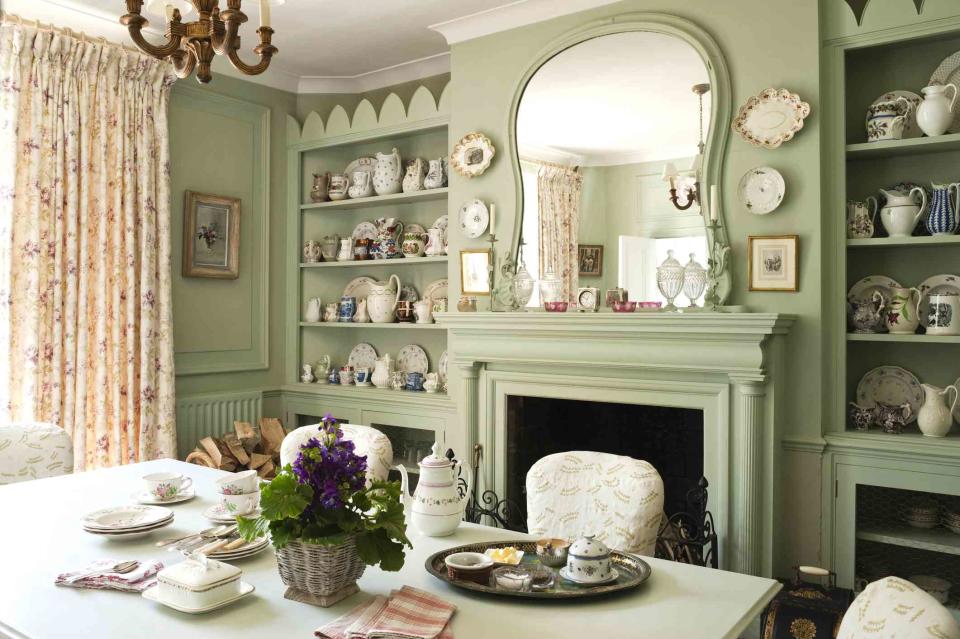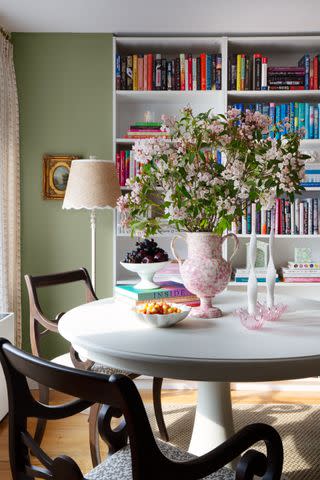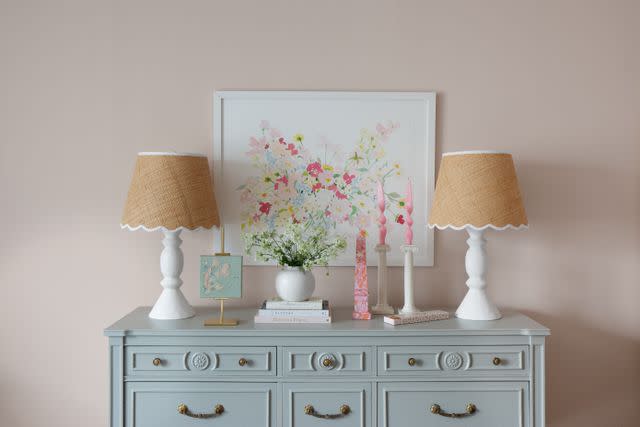All About the English Country Design Trend—and How It's Different From Farmhouse
English country design is all about coziness, layering, and a lived-in feel.

Any Anglophile can tell you, there’s nothing more welcoming or perfectly stylish than a centuries-old English country house and the antiques, florals, and timeworn books that line its rooms. An overstuffed chair draped in chintz sitting by a stone fireplace. Muddy wellies tossed aside next to a leather sofa covered in a wool tartan blanket. A bedroom with layers of block print, floral, and collected pillows thrown about. These perfectly imperfect scenes are what define English country design, and they’re having a moment in the décor world. We spoke with designers to fully flesh out what English country design is, and how you can incorporate it into your home.
Meet Our Expert
Shannon Claire Smith, founder and principal of Shannon Claire Interiors
Jennifer Hunter, founder of Jennifer Hunter Design
Related: 16 Most Common Interior Design Styles, From Art Deco to Scandinavian
English Country Design, Explained
Shannon Claire Smith, founder and principal of Shannon Claire Interiors, spends time antiquing in the English countryside and taking in the centuries-old aesthetic. With another trip on the horizon this spring, Smith incorporates English country design into much of her work. "English country design emphasizes accessible but elevated living," says Smith. "Nothing is too precious, and they're great at incorporating hyper-functional spaces like boot rooms and utility rooms that really allow for the indoor-outdoor living that the countryside is known for."
It’s also a look that isn’t afraid of layers, textures, collections, and patterns. "So much of English country design is in the mix of pattern," says Jennifer Hunter, founder of Jennifer Hunter Design. "It mixes florals and florals while still feeling polished."
Related: How to Identify an Antique When You See One
The Elements That Make Up English Country Design
At its core, English country design feels inviting and warm. It’s as if you’re stepping into the home of an effortlessly graceful person with a penchant for antiquing, a spot of tea perpetually ready to boil on the stove, and rooms full of heirloom collections. "These homes and spaces are meant to be lived in and enjoyed, and the design aesthetic reflects that," says Smith.
Comfort
Comfort is emphasized first and foremost in this design philosophy. "Plush, overstuffed chairs and sofas, soft, durable upholstery in every room, and ample seating are the first things I notice when touring great English homes or staying in a cozy country hotel," says Smith. "I try to incorporate this at home and make sure that each room has multiple comfy spots to perch—preferably by a fireplace!"

Jennifer Hunter
Florals
Printed florals are a key element of getting this look right. "You want a bouquet look. The florals should have the look of an English garden," says Hunter. She loves to put multiple florals side-by-side for a classically British look; she recently used four florals on one bed in a project. The key was making sure the scale of each print worked together and tying them with a simple two-tone pink and green palette.
Muted Color Palettes
English country design typically features a more muted palette—think shades of pink and sage green that feel a bit faded and lived in. The room should feel as if you’ve just stepped into an overflowing, abundant English garden at the height of spring blooms, but a bit subdued.
Related: 12 Living Room Color Schemes That Will Make It Your Favorite Space in the House
Indoor-Outdoor Living
Right in line with current design trends, bringing nature into the mix is done by way of flowers and greenery. "Organic shapes and natural elements like flowers and greenery found in the surrounding areas are key to this style of design," says Smith. "These emphasize the indoor-outdoor living that's prevalent in the area."
The Undone Done
English country design should feel as if it’s been organically curated over decades. Nothing should be perfect—inherited pieces, found antiques, and homemade décor all co-exist together. The result is a casual look. "It’s undone done. It’s relaxed and lived in," says Hunter, who adds that, of course, behind the scenes, there’s work to bring together this beautifully effortless look.

Per Magnus Persson / Getty Images
The Difference Between English Country Design and Modern Farmhouse
These two design styles have some similarities, but there are a few key differences. "Farmhouse is more of a weathered, hand-painted, repurposed look," says Hunter. The farmhouse style features simple forms and silhouettes that feel like classic Americana. Historically, these weren’t intended to be ornate or stylish pieces—they were functional above all else. Even as these features have made their way into the modern farmhouse era, the basic tenets of farmhouse design remain simple, rustic, and utilitarian.
English country design, however, is incredibly cozy yet purposefully mixed, matched, and styled. "The pieces are from all over," says Hunter. "There are French and British antiques. It’s collected but polished."
Tips for Incorporating English Country Design Into Your Home
Utilizing an English country design theory in your home means striking a careful balance between English elements and a fresh approach.

Jennifer Hunter
Fill the Space With Natural Elements
But she also interprets this as a merging of indoors and out, no matter where you live. Imagine yourself as Queen Elizabeth coming home from a walkabout. "Make sure you have functional spaces for all of the elements you need when you're outside and coming home—a spot for boots and shoes, a chic umbrella stand, coat hooks for scarves and hats, and the like," she says.
Related: Biophilic Design Is About Connecting With Nature—Here's How to Utilize the Décor Trend In Your Home
Add a Quirky Touch
The English accent may sound formal, but they’re known for their love of quirky references and offbeat humor. Smith uses a vintage toast caddy by the front door to organize mail. "It’s a cheeky nod to the Brits and their fabulous breakfasts," she says.
Use What You Love
If you use what you love, whether a fabric, a print, or a one-of-a-kind antique, the resulting look will work because it’s unique to you. "Don’t be afraid to throw in a random floral pillow because you love it," says Hunter.

Jennifer Hunter
Layer, Then Layer Some More
English country spaces feel warm and welcoming in large part because of the textures and textiles that fill the rooms. Natural fibers, blankets, organic materials, and upholstered furniture create a soft, comfortable space.
"Start with a natural fiber rug for warmth and durability, and layer in different finishes in the room by incorporating natural woods, stone, and metal pieces in the furniture," Smith says. "Finish the space with thick and heavy drapery to add coziness and warmth to the room." She suggests staying away from solids, leaning into patterns, and letting any worry about clashing take a back seat. "If you’re stuck, a good rule to stick to is one large organic pattern, like a chintz, add a geometric, like a stripe, then finish it with one small print pattern, such as a block print," she says.
Related: How to Layer Rugs to Bring Visual Interest to Your Space
Add a Few Modern, Sleek Pieces
So you don’t feel as if you’ve stepped onto the set of the movieThe Holiday, use well-placed modern and sleek elements to keep your English country space from feeling too literal. "Adding a few modern, plain pieces keeps it feeling fresh," Hunter says. "White nightstands contrast against a dusty rose. Not every frame has to be antique. Incorporate a midcentury lamp. Make it feel collected, yet light and airy."

Jennifer Hunter
Keep the Styling Casual
It might seem counterintuitive, but this look is anything but stuffy and formal. "Nothing should be perfect or symmetrical. There could be two different end tables or a lampshade that doesn’t match the others. It comes together organically," says Hunter.
Incorporate What You Have
The styling should feel undone like it was "plucked from an English garden and plopped into a vase you had," says Hunter. She suggests incorporating fruit and other things that might be lying about to finish your styling. "You’re not just finding something online. You’re finding things that are one of a kind and styling those," she says.
Make It Liveable
"No matter how formal or cozy the home, there seems to be a preference for durable and patterned textiles, natural stone and woods, and real, functional spaces," says Smith. English country design isn’t about what looks good in photos—it’s real-life design.
Read the original article on Martha Stewart.

